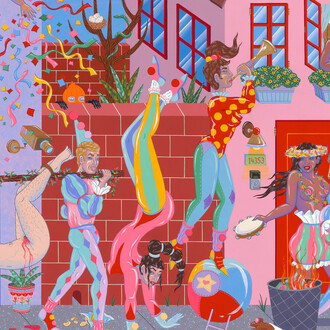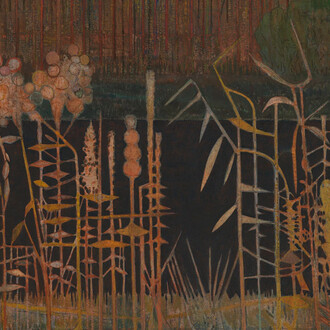The German word Heimlich in this case refers to “secretive” and/or “cozy.” Freud referenced Heimlich to invoke “buried beneath.” In America, the reference is usually to Dr. Henry Heimlich (the originator of the abdominal thrust).
Margarete Hahner, who lives primarily in Los Angeles, was born in Bamberg, Germany. After obtaining a Master’s Degree in Painting in Karlsruhe, Germany (where she studied with the Danish painter Per Kirkeby), she lived and worked in Europe, settling in Berlin in 1988, just before the wall came down. In 2006, she moved her studio to Los Angeles.
Highly influenced by the Catholic imagery of her childhood in Bamberg, Bavaria, much of her early work related to church art and church windows, wherein stories were conveyed in simple images.
In many ways conventional in their depictions, Hahner’s work frequently employs “simple” subversive elements that upsets the overall effect. In this show, the painting Gnome has an initial vaginal reference, subsequently revealed to be a Karl Marx-like visage of a bearded man. Transubstantiation invokes the miracle of digestion with the Catholic idea of changing bread and wine into the body and blood of Christ.
The “Heimlich” show also displays Hahner’s ongoing fascination with natural history represented by Fly (Museum); as well as a nod to her German origins in Door (Bamberg) and her interpretation of the mystical fascination of humanity with the materialistic in Parfume.
Since arriving in California, Hahner’s work has become increasingly expansive in size, whereby canvases take on the shape of a wall-covering or tapestry. There is also a more pronounced use of bright colors in the work, as if to say the light in Southern California called for a more vibrant color scheme. Her Tableau Vivant and American Birds are two examples in this show.
She has not entirely abandoned her fascination with incongruous images in this body of work. She is still interested in subverting a painting with aberrations centering on extremities such as hands, feet, as well as everyday items like pots and bottles. There is also an abundance of orbs, characters out of fairy tales, and reflections.
The key that links these disparate objects is an element of surprise. There can be an initial appraisal of a work, followed by the discovery of facets that possibly undermine one’s initial appraisal. Hahner likes the provocative invocation.
Suffice it to say, the observed image is not always the intended content of any given work.
I am attracted to the the idea that doing art is like going to confession and changing something negative into something positive. Depending on your perspective that could be read as Metamorphoses, double meaning, or better still, ambiguity over what is exactly what, when? “I strive to give my work a like sensibility: what exactly is what, when?”
(Margarete Hahner)
















